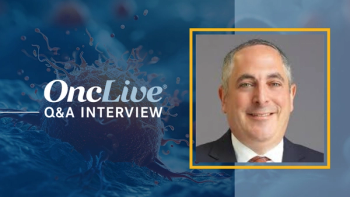
Better Understanding of Biomarkers Can Inform Immunotherapy Treatment in SCLC
FDA approvals in recent years have started to carve out a role for immunotherapy in the frontline treatment of patients with small cell lung cancer.
FDA approvals in recent years have started to carve out a role for immunotherapy in the frontline treatment of patients with small cell lung cancer (SCLC). However, properly identifying those who can benefit from immunotherapy remains a challenge as investigators try to establish a more personalized approach to SCLC treatment, according to Anne Chiang, MD, PhD.
“We need to understand how we can develop more options for patients who are refractory or resistant [to immunotherapy],” Chiang said in a presentation at the 20th Annual Winter Lung Conference.1 “We can turn to our biology to try to leverage some of our understanding of these therapeutic vulnerabilities of different subtypes of SCLC.”1 “We can turn to our biology to try to leverage some of our understanding of these therapeutic vulnerabilities of different subtypes of SCLC.”
In her presentation, Chiang discussed the current role of immunotherapy in SCLC, explained how a deeper understanding of the disease’s biomarkers could inform immunotherapy and other treatment decisions, and highlighted novel agents under investigation. Chiang is an associate professor of Medicine at the Yale School of Medicine and the associate director of Clinical Initiatives at Smilow Cancer Hospital Care Center in New Haven, Connecticut.
Immunotherapy and the Goal of Better Identifying Molecular Subtypes in SCLC
In May 2019,
Patients were randomly assigned in a 1:1 fashion to atezolizumab plus carboplatin/etoposide or placebo plus carboplatin/etoposide for four 21-day cycles as induction therapy, followed by maintenance atezolizumab or placebo, which continued until disease progression or loss of clinical benefit.
Updated from the study showed that patients treated with atezolizumab plus chemotherapy (n = 201) experienced a median overall survival (OS) of 12.3 months (95% CI, 10.8-15.0) compared with 10.3 months (95% CI, 9.3-11.3) for those given chemotherapy alone (n = 202; HR, 0.76; 95% CI, 0.60-0.95; P = .0154).3 Additionally, the 12- and 18-month OS rates were 51.9% and 34.0%, respectively, for patients in the atezolizumab arm. In the chemotherapy arm, those rates were 39.0% and 21.0%, respectively.
Study authors noted that patients derived benefit from the addition of atezolizumab, irrespective of PD-L1 immunohistochemistry or blood-based tumor mutational (TMB) status. In the subgroup of patients with PD-L1 expression of less than 1% in tumor cells and tumor-infiltrating immune cells, atezolizumab plus chemotherapy elicited a median OS of 10.2 months (95% CI, 7.9-15.7) compared with 8.3 months (95% CI, 6.9-9.1) for chemotherapy alone (HR, 0.51; 95% CI, 0.30-0.89). Patients with PD-L1 expression of at least 1% in tumor cells or tumor-infiltrating immune cells experienced a median OS of 9.7 months (95% CI, 7.6-17.4) in the atezolizumab plus carboplatin/etoposide arm vs 10.6 months (95% CI, 8.3-14.7) for those in the placebo plus carboplatin and etoposide arm (HR, 0.87; 95% CI, 0.51-1.49).
Furthermore, patients with tumors containing PD-L1 expression of at least 5% in tumor cells or tumor-infiltrating immune cells achieved a median OS of 21.6 months (95% CI, 9.4–not evaluable) with atezolizumab plus chemotherapy compared with 9.2 months (95% CI, 6.10-15.7) with placebo plus chemotherapy (HR, 0.60; 95% CI, 0.25-1.46).
“Using a TMB cut point of 10 mut/mb, if patients were [above or below 10 mut/mb], there was no difference [in OS between the 2 arms],” Chiang explained.
Another immunotherapy regimen entered the frontline treatment paradigm in March 2020 when
The regulatory decision stemmed from data from the phase 3 CASPIAN trial (NCT03043872), which evaluated durvalumab plus chemotherapy with or without tremelimumab-actl (Imjudo) vs chemotherapy alone in patients with treatment-naïve ES-SCLC with measurable disease per RECIST v1.1 criteria. Eligible patients had a WHO performance status of 0 or 1, a life expectancy of at least 12 weeks, and brain metastases that were asymptomatic or treated and stable.5
Findings from a 3-year OS update showed that patients treated with durvalumab plus chemotherapy (n = 268) experienced a median OS of 12.9 months (95% CI, 11.3-14.7) compared with 10.5 months (95% CI, 9.3-11.2) for those given chemotherapy alone (n = 269; HR, 0.71; 95% CI, 0.60-0.86; P = .0003). At 36 months, the OS rate was 17.6% and 5.8% for those in the durvalumab arm and chemotherapy alone arm, respectively.
“I use both of these regimens [Impower133 and CASPIAN], and patients do very well on them,” Chiang noted.
Regarding PD-L1 expression, Chiang explained that the biomarker’s role is very different in SCLC compared with non–small cell lung cancer (NSCLC). She added that clinicians hope to use biomarkers to personalize treatment decisions for patients with SCLC in the same manner as NSCLC.
“To date, we haven’t had any inklings that [using biomarkers to tailor therapy decisions] could be useful [in SCLC]. However, I think things are changing a little bit,” Chiang said.
In a study published in Nature Reviews Cancer in 2019, researchers identified categorized SCLC by molecular subtype.6 SCLC-A was characterized by an over-transcription of ASCL1, SCLC-N featured overexpression of NEUROD1, SCLC-P had over expression of POU2F3, and SCLC-Y had overexpression of YAP1. Additionally, SCLC-I was identified as an inflamed subtype.
“This is not ready for prime time in the clinic…However, patients with SCLC-I did much better with atezolizumab [plus chemotherapy in IMpower133], and that benefit disappeared in the placebo arm,” Chiang said. “So perhaps that SCLC-I subtype is something that might indicate which patients might benefit from immunotherapy. For subtypes A, N, and P, there are potential therapeutic vulnerabilities there that we might be able to target.”
Lurbinectedin and Other Options in the Relapsed Setting
Pembrolizumab (Keytruda) and nivolumab (Opdivo) both received approval from the FDA as single-agent treatments in the relapsed setting for SCLC. However, the indication for nivolumab was withdrawn in December 2020 and pembrolizumab followed when its indication was withdrawn in March 2021. 7,8
Despite the withdrawals, Chiang noted that durable responses were observed in a portion of patients who received pembrolizumab or nivolumab in relapsed setting. Findings from the phase 2 KEYNOTE-028 trial (NCT02054806) led to FDA accelerated approval of pembrolizumab in this setting. Among the 16 patients who achieved a response, 94% had a response of at least 6 months, 63% had a response of at least 12 months, and 56% had a response of at least 18 months.
In the phase 1/2 CheckMate-032 trial (NCT01928394), which supported the accelerated approval of nivolumab, 77% of the 13 responders had responses of at least 6 months, 62% were ongoing at least 12 months, and 39% had a response of at least 18 months.
“Those patients who responded did very well…It is important to understand the [implications of] biomarkers [for patients in the relapsed SCLC setting],” Chiang said.
“[Nivolumab and pembrolizumab] were subsequently withdrawn by the sponsors because of phase 3 trials that were negative. Is this going to happen to lurbinectedin [Zepzelca]?” she added.
The FDA
Under the current NCCN guidelines, platinum-based doublet chemotherapy or clinical trial remains the preferred subsequent therapy regimen for patients with SCLC, with lurbinectedin and others falling under other recommended regimens.11 Rechallenging with the original platinum-based chemotherapy doublet or a similar regimen is recommended for patients who have a disease-free interval of more than 6 months, although patients may be considered if the disease-free interval is at least 3 to 6 months.
Novel Agents Under Investigation in SCLC
The bispecific T-cell engager tarlatamab (AMG 757) combines the binding specificities of DLL3 and CD3. Investigators hope to improve immune response in patients with SCLC by targeting DLL3.
Findings from a phase 1 trial (NCT03319940) showed that patients with SCLC (n = 64) treated with doses of tarlatamab ranging from 0.3 mg to 100 mg experienced an ORR of 20%.12 At the 100 mg target dose, the ORR was 27% (n = 3/11).
The SEZ6-targeted antibody-drug conjugate is also under investigation as monotherapy and in combination with ABBV-181 in patients with relapsed/refractory SCLC. SEZ6 is upregulated in the majority of primary SCLC tumors, and the primary mechanism of action for SC-011 is binding of the agent to SEZ6 on tumor cells.
References
- Chiang A. Updates in SCLC. Presented at: 20th Annual Winter Lung Cancer Conference; February 3-5, 2023; Hollywood, FL. Accessed February 6, 2023.
- FDA Approves Genentech’s Tecentriq in Combination With Chemotherapy for the Initial Treatment of Adults With Extensive-Stage Small Cell Lung Cancer. Genentech (Roche). Published March 18, 2019.
gene.com/media/ - Liu SV, Reck M, Mansfield AS, et al. Updated overall survival and PD-L1 subgroup analysis of patients with extensive-stage small-cell lung cancer treated With atezolizumab, carboplatin, and etoposide (IMpower133). Liu SV, Reck M, Mansfield AS. J Clin Oncol. 2021;39(6):619-630. doi:10.1200/JCO.20.01055
- Imfinzi approved in the US for extensive-stage small cell lung cancer. News release. AstraZeneca. March 30, 2020. Accessed February 6, 2023.
https://www.astrazeneca.com - Paz-Ares L, Chen Y, Neinmuth N, et al. Durvalumab ± tremelimumab + platinum-etoposide in first-line extensive-stage SCLC (ES-SCLC): 3-year overall survival update from the phase III CASPIAN study. Ann Oncol. 2021:32(suppl 5):S1283-1346. doi: 10.1016/j.annonc.2021.08.2142
- Rudin CM, Poirer JT, Byers LA, et al. Molecular subtypes of small cell lung cancer: a synthesis of human and mouse model data. Nat Rev Cancer. 2019;19(5):289-297. doi:10.1038/s41568-019-0133-9.
- Bristol Myers Squibb statement on Opdivo (nivolumab) small cell lung cancer US indication. News release. Bristol Myers Squibb. December 29, 2020. Accessed February 6, 2023.
news.bms.com - Merck provides update on KEYTRUDA (pembrolizumab) indication in metastatic small cell lung cancer in the US. News release. March 1, 2021. Accessed February 6, 2023.
http://merck.com/ - FDA grants accelerated approval to lurbinectedin for metastatic small cell lung cancer. News release. FDA. June 15, 2020. Accessed February 6, 2023.
fda.gov - Trigo J, Subbiah V, Besse B, et al. Lurbinectedin as second-line treatment for patients with small-cell lung cancer: a single-arm, open-label, phase 2 basket trial. Lancet Oncol. 2020;21(5):645-654. doi:10.1016/S1470-2045(20)30068-1
- Clinical practice guidelines in oncology, small cell lung cancer, version 2.2023. NCCN. Accessed February 6, 2023.
nccn.org - Owonikoko TK, Champiat S, Johnson ML, et al. Updated results from a phase 1 study of AMG 757, a half-life extended bispecific T-cell engager (BiTE) immuno-oncology therapy against delta-like ligand 3 (DLL3), in small cell lung cancer (SCLC). J Clin Oncol. 2021;39(suppl 15):8510. doi:10.1200/JCO.2021.39.15_suppl.8510

























































































